NO Salt / NO Scale / NO Maintenance
/ NO Filter Change
Whole House Water Filtration System
Rising Challenges of Drinking Water
Potential Risk of the Water for your family
Contamination
Even when the incoming process water is from a municipal drinking water source, the water may contain trace organics and residual tastes, odors, disinfection by-products, and free- and combined-chlorine that requires final filtration/removal. Depending on the quality of the incoming water, there are a variety of activated carbon products and solutions that improve water quality
The U.S. EPA has compiled a list of 100 potentially risky chemicals and 12 microbes that are known or expected to be found in public water systems, but are not yet regulated. The Whole House Water Filtration System will solve the problems
How Lead Gets into Drinking Water
- the chemistry of the water (acidity and alkalinity) and the types and amounts of minerals in the water,
- the amount of lead it comes into contact with,
- the temperature of the water,
- the amount of wear in the pipes,
- how long the water stays in pipes, and
- the presence of protective scales or coatings inside the plumbing materials.
Lead is harmful and it can cause health risk:
- Cardiovascular effects, increased blood pressure and incidence of hypertension
- Decreased kidney function
- Reproductive problems (in both men and women)
- Behavior and learning problems
- Lower IQ and hyperactivity
- Slowed growth
- Hearing problems
- Anemia
What Are PFOA and PFOS?
Perfluorooctanoic acid (PFOA) and perfluorooctanesulfonic (PFOS) acid are part of a group of chemicals commonly referred to as perfluoroalkyl substances (PFASs) or perfluorinated compounds (PFCs). PFOA and PFOS are man-made chemicals that up until 2000 had been widely used in the manufacturing of many industrial and consumer products such as paper and cardboard food packaging, insecticides, electronics, stain repellants, paints, plumbing tape, firefighting foam and non-stick cooking surfaces.
Prior to phasing PFOA and PFOS out of production, large quantities were released into the environment during the manufacturing processes and have been found to have contaminated the drinking water supplies near current or former manufacturing locations.
Exposure to unsafe levels of PFOA/PFOS concentrations through drinking water may result in health effects including developmental effects to fetuses during pregnancy, cancer, liver effects, immune effects and thyroid effects.

Chlorination by-products
Chlorine disinfection is carried out for the purpose of sterilization of microbes existing in drinking water. Chlorination may cause the formation of disinfection by-products (DBPs) by the reaction of free chlorine with humic substance in the water. In particular, the DBPs including trihalomethanes (THMs), haloacetic acids (HAAs), haloacetonitriles (HANs), and haloketones exist in tap water.
In laboratory tests, lab animals exposed to very high levels of THMs have an increased risk of cancer. Several studies on humans have also found a link between long-term exposure to high levels of chlorination by-products and a higher risk of cancer. For instance, a recent study showed an increased risk of bladder and possibly colon cancer in people who drank chlorinated water for 35 years or more. High levels of THMs may also have an effect on pregnancy.
A California study found that pregnant women who drank large amounts of tap water with high THMs had an increased risk of miscarriage. These studies do not prove that there is a link between THMs and cancer or miscarriage. However, they do show the need for further research in this area to confirm potential health effects. For HAAs, there is a concern that long-term exposure to elevated levels may pose an increased risk of developing cancer. In addition, there is some evidence in animal studies that exposure may be linked to development and reproductive effects.
Volatile Organic Compounds (VOCs)
Volatile Organic Compunds (VOCs) are a class of chemicals that are carbon-containing and evaporate, or vaporize, easily into air at normal air temperatures. VOCs are found in a variety of commercial, industrial, and residential products, including gasoline, solvents, cleaners and degreasers, paints, inks and dyes, and pesticides. When VOCs are found in the environment it is typically the result of human activity, such as a spill or inappropriate disposal where the chemical has been allowed to soak into the ground. Once released into the environment, VOCs may be carried deeper into an aquifer in the form of a non-aqueous phase liquid (NAPL), evaporating low concentrations of VOCs as it is transported through the subsurface.
The U.S. Environmental Protection Agency (EPA) estimates that VOCs are present in one-fifth of the nation’s water supplies. They can enter drinking water supplies from a variety of sources.
Benzene, for example, may enter groundwater from gasoline or oil spills on the ground surface or from leaking underground fuel tanks. Other examples of commonly detected VOCs are dichloromethane (methylene chloride), an industrial solvent; trichloroethylene, used in septic system cleaners; and tetrachloroethylene (perchloroethylene), used in the dry-cleaning industry. Exposure risk is determined based on the individual constituents of the VOC compound, with each having the potential to trigger different symptoms, human health effects, or illnesses.

Hard Water Scale
Water is a very efficient universal solvent in nature. When water flows on the surface of grounds natural minerals such as calcium, magnesium, iron and other chemicals will be dissolved and carried to lakes and underground water sources.
Hard water is not a health problem. Hard water contains high concentration of calcium and magnesium. It could be a major contribution of healthy minerals in your body. However, hard water will be a nuisance when it interacts with plumbing systems and water appliances and causes scale on shower heads, shower walls, bathtubs, sinks, faucets, pipes, washing machines and dishwashers.
Awareness of the importance of minerals and other beneficial constituents in drinking water has existed for thousands years. Following research from WHO(World Health Organization) will explain about “HEALTH RISKS FROM DRINKING DEMINERALISED WATER”
Solutions
ANovaEco Whole House Water Filtration Systems provide sophisticated solutions equipped with high quality and cutting edge technology to remove contaminants and hard scale buildup by using powerful combination of Filtration and Descaling System with
NO Salt, NO Scale, NO Maintenance, NO Filter Change
1st Process : Filtration System - The Best way to remove Contaminants

Automated and Sophisticated Design
Keep Healthy Minerals
Improve Water Taste
The tap water usually tastes metallic or unfavorable aroma. This taste is often due to the additives, such as chlorine, that are added to tap water to kill bacteria and pathogens found in water source.
no Maintenance
It is important to make sure carbon is always clean. The adsorption capability of catalytic carbon allows the maintenance of carbon efficient as long as the system has a powerful automatic back wash feature.
Remove Heavy Metals
Remove Contaminants
Boost up pH
KDF(Kinetic Degradation Fluxion)
KDF® process media are high-purity, copper-zinc formulations that reduce contaminants in water using an oxidation/reduction (redox) reaction. In other words, KDF media exchange electrons with contaminants, changing them into harmless components. For example, chlorine is changed into soluble chloride, soluble ferrous cations are changed into insoluble ferric hydroxide, and hydrogen sulfide is changed into insoluble copper sulfide. Insoluble reaction by-products are easily removed by periodic backwashing.
Other heavy metals such as lead, mercury, copper, and nickel are removed simply by bonding to the KDF media. Microorganisms, however, are controlled two ways: First, the exchange of electrons in the redox reaction creates an electrolytic field that most microorganisms can’t survive. Second, KDF process media may catalyze the formation of radicals and peroxides in certain circumstances. The radicals can interfere with microorganisms’ ability to function.
KDF Process Media can remove up to 99% of water-soluble cations (positively-charged ions) of lead, mercury, nickel, chromium, and other dissolved metals. All KDF Process Media forms are effective in controlling the buildup of bacteria, algae, fungi and scale, making them ideal for use in Catalytic Activated Carbon System.
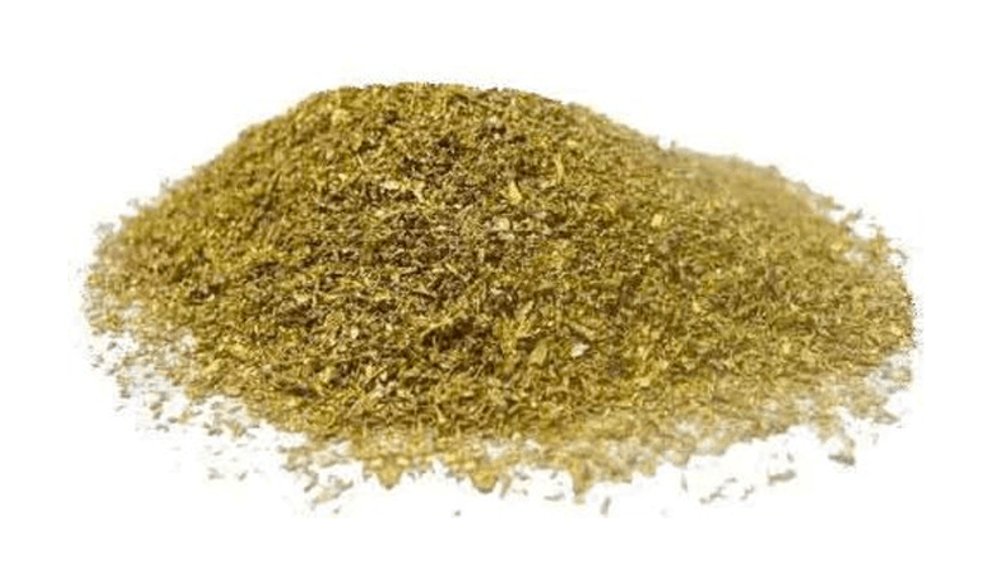

CENTAUR Activated Catalytic Carbon
With enhanced catalytic properties, CENTAUR accelerates reaction rates, reduces chemical requirements and results in efficient conversion of reactants into products. CENTAUR is utilized in liquid phase for promotion of oxidation, reduction, decomposition, substitution, and elimination reactions.
- Hydrogen Sulfide Removal (liquid phase) where H2S in converted to sulfate to eliminate sour taste and odor in potable water
- Decomposing chloramines in potable water faster than standard activated carbons
- Acting as a dual-purpose media, providing both filtration and adsorption for treating surface water and groundwater sources in the production of drinking water
The U.S. Environmental Protection Agency (EPA) and most state-based departments of health consider adsorption by granular activated carbon (GAC) to be the best available technology for the removal of many organic materials in surface water
- Disinfection byproducts (DBPs) associated with chlorine and alternative disinfectants
- Volatile Organic Compounds(VOCs)
- Algal toxins, such as microcystin-LR and anatoxin-A
- Bacteria, viruses and parasites such as cryptosporidium and giardia
- Endocrine-disrupting compounds (EDC)
- Pharmaceuticals and personal care products (PPCP)
- Taste and odor-causing compounds (T&O)
- Organic materials from decaying plants and other naturally occurring matter (NOM) which serve as the precursors for DBPs
Automated Self Maintenance
In water filtration system, the quality of water critically depends on how effectively the filtration system operates. One of major components in making sure the filtration system working at its best is the performance of backwashing processes.
Backwashing of granular media filters involves the compressed air to be pushed up through the filter material causing the filter bed to expand breaking up the compacted filter bed and forcing the accumulated particles into suspension. After the air scour cycle, clean backwash water is forced upwards through the filter bed continuing the filter bed expansion and carrying the particles in suspension into backwash troughs suspended above the filter surface and all filtered contaminants will be removed through a drain line connected to water filtration system. Air and water streams are simultaneously pushed upwards through the granular media followed by a rinse water wash. Backwashing continues for a fixed time at a programmed schedule. At the end of the backwash cycle, the upward flow of water is terminated and the filter bed settles by gravity into its initial configuration.
Vortech® - innovative and efficient universal distribution system to maximize backwash perfomance
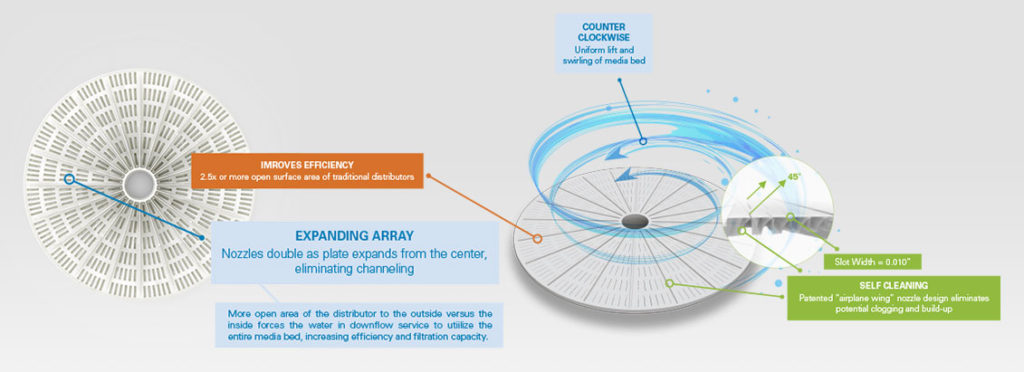
Patented self-cleaning nozzle design accelerates the velocity of water across the co-polymer polypropylene distributor, preventing the potential build-up of iron and other potential contaminants, in a wide range of water filtration applications.
The Vortech™ technology will improve the efficiency of the exchange bed, and extends the life of the media bed by reducing channeling and time to breakthrough. The product design incorporates a radial pattern that forces water to utilize the entire media bed, with greater than 2.5 times the open surface area of typical baskets. Capacity improves up to 15% and pressure loss properties are improved by nearly 40%. The Vortech™ saves time, money and the environment.

Is your Water from a private Well ?
AIO - Breakthrough in Iron and Sulfur Removal Technology
AIO(Air Injection Oxidizing) Filter System, as a single tank system, is an efficient and cost effective system for the removal of iron and sulfur. The AIO system can remove up to 8 ppm of Hydrogen Sulfide and up to 7 ppm Iron. A daily backwash will remove accumulated iron and replenish the filter media bed. The regeneration process also adds a fresh air pocket to the system.
AIO system maintains an air pocket in the top of the tank while the system is in service. As the water passes through the air pocket, iron and sulfur are oxidized out. Additionally, dissolved oxygen is added to the water. The AIO filter media bed then removes the iron and sulfur from the water.
Different parts of areas where underground well is used as a source of house water have been reported to remove unchallenged amounts of iron. In a few extreme cases multi-stage Katalox-Light filtration systems have been used without the use of any chemicals to remove iron with inlet concentration of as high as 60 – 100 mg/L (ppm). Katalox-Light is also a good filtration media for sand, sediment and suspended solids, down to 3 micron.
Katalox-Light® is WQA Certified to meet ANSI/NSF 61 standard for Drinking Water applications. It has very high surface area to be able to remove Iron, Manganese, Arsenic, Hydrogen Sulfide and other various Heavy Metals. Media is coated with High MnO2(10%) and contains NO crystalline Silica.
Iron is a common water contaminant. Iron removal can be difficult because it may change its valence state that is change from the water soluble ferrous state (Fe2+) to the insoluble Ferric state (Fe3+). When Oxygen or an oxidizing agent is introduced, ferrous states changes to ferric which is insoluble and it precipitates, leading to a rusty (red-brown) appearance in water. This change can occur when deep well water is pumped into a distribution system where it adsorbs oxygen. Ferric iron has to be removed before it destroys valves, piping all other water filtration equipments and water-using devices. Katalox-Light® provides a large filtration area and high catalyst to speed up the process.

EOG(Enhanced Oxidation Generator) Powerful, Natural, Chemical Free Disinfectant
Ozone has been proven to have a much higher disinfection potential compared to all other disinfectants available for use today. It effectively kills bacteria, fungi, viruses and parasites in the media bed, including those causing human disease and food spoilage. Naturally occurring from sunlight, ultraviolet rays and lightning, ozone is nature’s way of controlling bacteria growth within our environment. Unlike other water filtration processes, ozone oxidation is a natural, chemical-free process that produces zero wastewater and leaves behind oxygen molecules much like the ones in the air we breath.
Built to Last
The Enhanced Oxidation Generator (EOG) leverages the power of natural ozone technology to improve water quality without the use of chemicals. With minimal maintenance costs, the EOG helps to keep the Water Filtration Filter control head clean, extending filter life and saving you money.
Improves Quality of Water
Ozone is proven to destroy microorganisms and remove minerals such as iron and magnesium instantly and effectively without harmful residue. The system will also assist in eliminating unwanted odors such as rotten egg, stale, or musty smells.
Low Maintenance
With no chemicals or pumps to maintain, the EOG requires very little maintenance. The system is also energy efficient drawing only milliamps per day.
NO Harmful Chemichals
Ozone has been proven to kill bacteria faster than chlorine, eliminating the need for traditional chemicals such as hydrogen peroxide or chlorine typically used to disinfect water. The EOG is safe for the environment including septic systems.
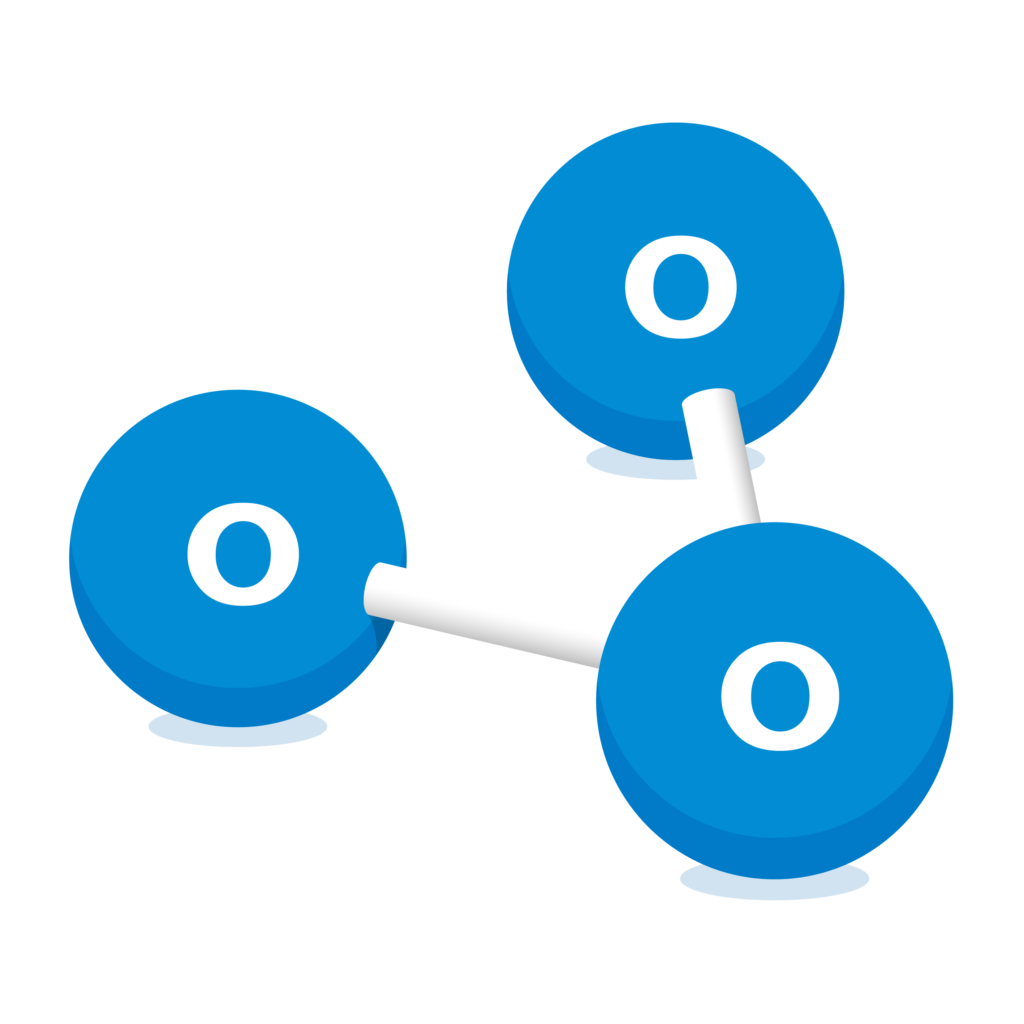
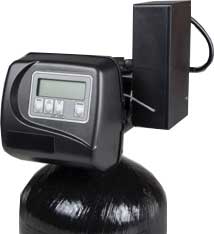
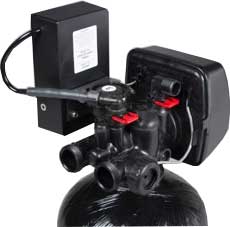
Chlorination System
Source : safewater.org
WHY DO WE CHLORINATE WELL WATER?
A large amount of research and many studies have been conducted to ensure success in new treatment plants using chlorine as a disinfectant. A leading advantage of chlorination is that it has proven effective against bacteria and viruses. Chlorine inactivates a microorganism by damaging its cell membrane. Once the cell membrane is weakened, the chlorine can enter the cell and disrupt cell respiration and DNA activity
Chlorine can react with a number of different substances. In raw water, there may be a number of different impurities to react with the added chlorine, resulting in an increase of the chlorine demand. As a result, more chlorine will need to be added for the same level of inactivation. Some major impurities that may exist in water include: dissolved iron, hydrogen sulphide, bromine, ammonia, nitrogen dioxide, and organic material.
In some cases, the result of chlorine reacting with impurities will increase the quality of the water (by eliminating the undesired elements), while in other cases, the chlorine-impurity reactions will create undesired side products that are harmful to human health. Chlorine will first react with inorganic impurities (dissolved iron, bromine, ammonia, etc.) before reacting with the organic compounds (dissolved organic material, bacteria, viruses, etc.)

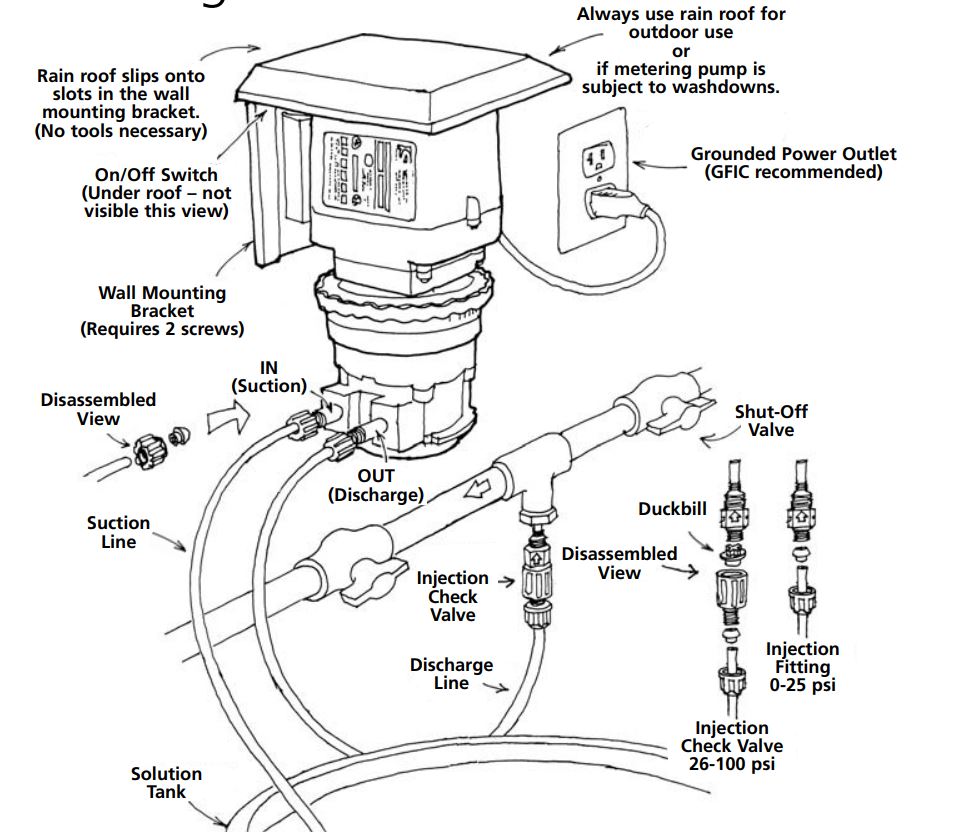
IMPURITY REACTION
Iron, which will give water an undesirable metallic taste if present, is one of the inorganic compounds that will react with hypochlorous acid. By reacting with hypochlorous acid, the dissolved iron will go from a soluble state to an insoluble state, as a precipitate is formed as a result of the reaction. The iron precipitate, in its insoluble state, can be removed by filtration process.
2 Fe2+ (liquid) + HOCl + 5H2O -> 2 Fe(OH)3 (solid) + 5H+ + Cl-
Hypochlorous acid can also react with hydrogen sulphide (H2S), if it is present in the water being treated. Hydrogen sulfide is an undesirable impurity in water because it gives water an undesired smell. At levels below 1 mg/L hydrogen sulphide generates a musty smell to the water, while at levels above 1 mg/L a rotten egg smell will prevail. Hydrogen sulphide is also toxic. The hypochlorous acid and H2S reaction gives hydrochloric acid and sulphur ions as its products.
H2S + HOCl -> H+ + Cl- + S + H2O
Bromine in the water can result in the production of undesired compounds. Bromine ions can react with hypochlorous acid to create hypobromous acid. Hypobromous acid also has disinfectant properties and is more reactive than hypochlorous acid. Hypochlorous acid or hypobromous acid will react with organic material in the water and create halogenated by-products, such as trihalomethanes.
Br- + HOCl -> HOBr + Cl-
Ammonia is a compound that may exist in the water. It is a nutrient to aquatic life, but one that will become toxic in high concentrations. Ammonia is produced as a result of decaying matter and therefore naturally exists in the water; however, human activity also releases a large amount of ammonia into the water, which contributes to an increasing level of ammonia that may cause concern. Some ‘human activity sources’ include: municipal wastewater treatment plants, agricultural releases, and industrial releases, such as pulp and paper mills, mines, food processing, and fertilizer production. Reactions between ammonia and chlorine will produce monochloramines, dichloramines, and trichloramines, which are collectively known as chloramines. These compounds are beneficial to the water treatment process as they have disinfection capacity, but they are not as effective as chlorine although chloramines will last longer in the water.
Chlorine also reacts with phenols to produce monochlorophenols, dichlorophenols, or trichlorophenols, which cause taste and odour problem at low levels. At higher levels, chlorophenols are toxic and affect the respiration and energy storage process. Chlorophenols are mainly man-made compounds, but can be found naturally in animal wastes and decomposing organic material.
2nd Process : Descaling System - Revolutionary way to eliminate Hardness
There are two ways to solve Hardness problem. One is to remove minerals, the other to convert them to non adhesive form. Our system DO NOT remove healthy minerals from water. We convert minerals from adhesive to non-adhesive form. Now you can enjoy minerals for your health and they do not stick to your plumbing and water appliances.
CareFree System

It’s not a water softener, it’s an inline water conditioner and it’s probably the best natural water filtration in the world. When you install one in your household, farm or industrial supply, your water problems will be a thing of the past
Calcium Carbonate (CaCO3) is the main cause of scale problems and costs industry and homeowners billions of dollars each year.
It appears predominately in two forms, Calcite (β-CaCO3) and Aragonite (λ-CaCO3). Although they share identical chemical compositions, they have completely different crystalline structures.
Calcite precipitates to form hard-to-remove whitish scale. Aragonite precipitates at a higher temperature, is much softer and more easily removed.

CALCITE
Chemical Formula: CaCO3
Molecular Weight: 100.09g
Calcium: 40.04% Ca
Carbon: 12.00% C
Oxygen: 47.96% O
ARAGONITE
Chemical Formula: CaCO3
Molecular Weight: 100.09g
Calcium: 40.04% Ca
Carbon: 12.00% C
Oxygen: 47.96% O

“There are three common forms of calcium carbonate, aragonite, calcite and vaterite. These materials are composed of the same chemicals and for all purposes have the same compositions, i.e the chemical formula is CaCO3). However the atoms of the minerals are arranged differently in space – this is called polymorphism.
Because these minerals are arranged differently in space, they have different properties. As you can imagine, some of these structures are stronger than others. For example, the solubility product of calcite is roughly a half of the solubility product of aragonite. Calcite is more insoluble in hot water (about 4 times for a 50 degree celcius temperature range) and thus is liable to drop out and form on hot surfaces. Aragonite forms at higher temperatures and tends to stay in solution longer. Thus it is likely to be present but still in solution.
We have conducted preliminary tests to show that aragonite forms at higher temperatures than calcite and that aragonite is preferentially formed when the Care-Free Conditioner was used. Techniques used were XRD, particle size measurements, and SEM.“
Dr Gary Lee BSc (Hons) PhD, Aqueous Geochemist, ANSTO
Microscopic Analysis of How Mineral Particles are changing structures

Mineral Particles Before CareFree
Calcium is naturally present in water. It may dissolve from rocks such as limestone, marble, calcite, dolomite, gypsum, fluorite and apatite. Calcium is a determinant of water hardness, because it can be found in water as Ca2+ ions. Magnesium is the other hardness determinant. Magnesium is washed from rocks and subsequently ends up in water. Magnesium has many different purposes and consequently may end up in water in many different ways.
Chemical industries add magnesium to plastics and other materials as a fire protection measure or as a filler. It also ends up in the environment from fertilizer application and from cattle feed.
These photos reveal mineral particles precipitated from “the same water sample” with a reading of 750mg/l hardness.
Note how the particles are bound together before Care-Free system, and “separated” after physical reaction.
Mineral Particles After CareFree
By applying a simple, yet totally natural water treatment process, the CareFree Water Conditioner helps neutralize the adverse effects of many of the undesirable substances in your water supply. The CareFree Water Conditioner is an in-line catalytic water treatment system. It operates by a combination of the following:
- Turbulence of the water through a specially designed catalytic chamber; and
- The creation of a small electrical field around the chamber casing.
This combination causes a separation of the mineral particles in the water, which changes their behavior. Particles, which were previously attracted to each other now repel and separate into smaller individual particles. This allows the “separated” mineral particles and salts to flow through the system with minimal interference.
Scientific Analysis has shown that the mineral particle size has reduced from 100-400 microns for untreated water, to around 30 microns for CareFree treated water. For example, you can compare this reduction in micron size from the size of your fist to the size of your fingernail.
(Electron Microscope Photographs. Mag. x 1400)
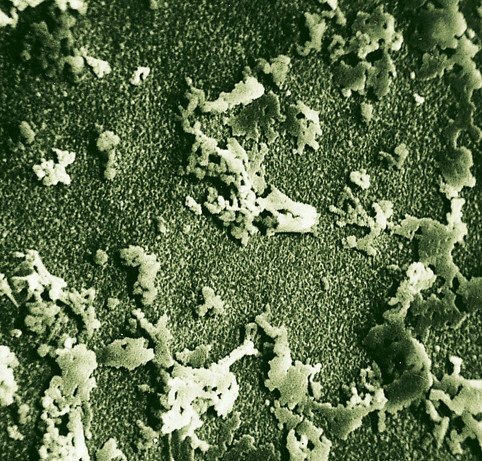
CareFree reduces scale and prevents corrosion
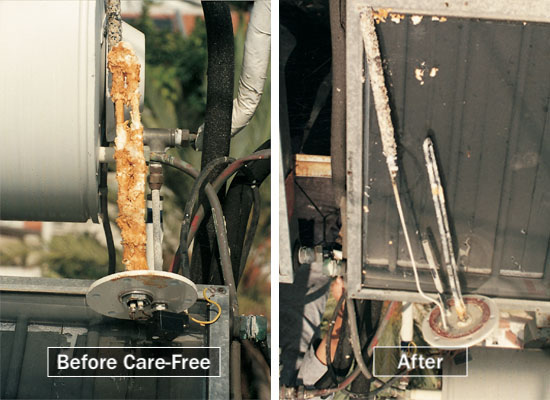
CareFree reduces scale caused by hard water
Before
This amount of scale on your hot water element can double your hot water bill.
After
However, six weeks after installation a Care-Free Conditioner, all scale has been removed!
CareFree helps prevent corrosion
Your hot water heater is fitted with a sacrificial anode to prevent corrosion of the cylinder. These anodes are one year old and from the same hot water heater.
(Sacrificial anodes are easily corroded materials deliberately installed in a tank to be sacrificed to corrosion, leaving the rest of the system relatively corrosion free)
CareFree increases longevity.
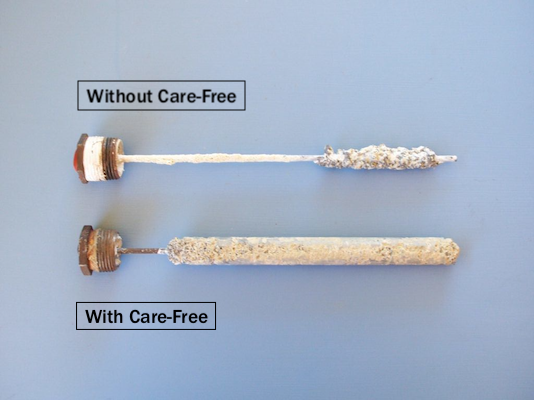
RESEARCH THESIS: Improved Scale Control Through Physical Turbulent Conditioning
By Luke Scott B.Eng. Hons1, M.Eng
University of Wollongong, Published 2013
ABSTRACT
A study of global water supply has been made. Five billion people are predicted to die between 2040 and 2060 if nothing is done. Desalination may present a solution, if effective scale control can be achieved.
An extensive study of scaling, calcium carbonate polymorphs, and existing scale control mechanisms and methods has been made. Many methods appear to exploit the same mechanism: changing a portion of calcium carbonate scale in its tenacious calcite form to the more easily removed aragonite. However, the mechanism behind changing forms is not known, and is currently impossible to test. There are many postulates, but no definitive proofs.
Investigations were made into an existing scaling control system known as the Care-Free Conditioner to determine its impacts on calcium carbonate scale. The system suits remote areas that have ‘hard water’ problems and little access to expensive treatments. The device relies on turbulence, and does not use magnets or electric currents. Tests have been made on the conditioner’s effects on particle size and scale morphology. The Care-Free Conditioner significantly reduces suspended calcium carbonate particle size by up to 50%. X-Ray Diffraction tests prove the Conditioner’s ability to change up to 70.2% of scale from calcite to aragonite, if the calcium carbonate was dissolved during conditioning. It does not change the morphology of suspended solid particles.
Computational Fluid Dynamics models of old and new Conditioner designs have quantified that the new spiral design at a flow rate of 10L/min produces 7.2 times the average turbulent kinetic energy (k) and 131 times the average turbulent energy dissipation (ε) of the old Venturi design at the same flow rate. There is room for further improvement, as the old and new designs have the bulk of their turbulence generated in the front half, with little at the end. Turbulent features of the old and new designs have also been quantified for a range of flow rates.
Turbulence results from CFD modelling have been combined with polymorph ratios calculated from XRD analysis to determine the optimum flow rate for calcite transformation. Results suggest a threshold value close to 2.45 x 10-3 J/kg for average k and 0.272 J/kg.s for average ε. Increasing flow rate and dissipating more energy beyond those values reduces the effect, and increases the amount of calcite. A possible mechanism has been described.
Turbulence results from CFD modelling have also been combined with particle size results to determine the optimum flow rate for particle reduction. The best result of a 50.0% reduction in particle size occurred at a flow rate of 0.193 kg/s. Results suggest that there is a threshold value at a flow rate of 0.11 kg/s (average k of 2.5 x 10-2 J/kg and average ε of 17.2 J/kg.s) for reducing particle size. Increasing the turbulence beyond that value does not significantly change particle size. The new design was shown to reduce particle size 35.3% more than the old design at the same flow rate.
The Care-Free Conditioner significantly reduces scaling problems in remote areas without expensive treatment by changing dissolved calcite to aragonite, and reducing suspended solid particle size.
The new design generates substantially more turbulence than the old design. Both can still be improved, as each design generates turbulence mainly in the front half, with comparatively little at the end.
This is the first time such findings have been achieved. These will contribute significantly towards the Care-Free Conditioner’s acceptance in the market, and in developing future Care-Free Conditioner designs

NUW[new] way
to remove contaminants
to make your water safe
Perfect Solution for removal of heavy metals including LEAD
NUW filtration POU(Point of Use) system contains a combination of KDF and highly activated catalytic carbon to give the maximum efficiency to remove various kinds of contaminants including heavy metals, chlorine, volatile organic compounds, disinfection byproducts, pharmaceuticals, personal care products, organics and many more. NUW will preserve healthy minerals and boost up alkalinity in a natural way without adding additives in your drinking water. NUW is the perfect solution to remove Lead from the source of your drinking water
When filtered through KDF® media, soluble lead cations are reduced to insoluble lead atoms, which are electroplated onto the surface of the media. Other heavy metals bond to the media and may be recovered when the exhausted media pass through a copper smelter.
- New Jersey’s Department of Environmental Protection and Energy uses KDF 55 redox alloy medium in point-of-entry treatment systems (POET) to remove mercury in residential applications. KDF media consistently reduce mercury from initial concentrations of 13 ppb through 24 ppb (parts per billion) to concentration levels below 0.5 ppb.
- Major U.S. circuit board manufacturer uses KDF media for 94.4% of lead removal in the effluent water used to rinse off printed circuit boards. The water is now recycled in a closed-loop rinse-down system, which saves the company approximately $10,000 each year.
A typical metal redox reaction with KDF process media
